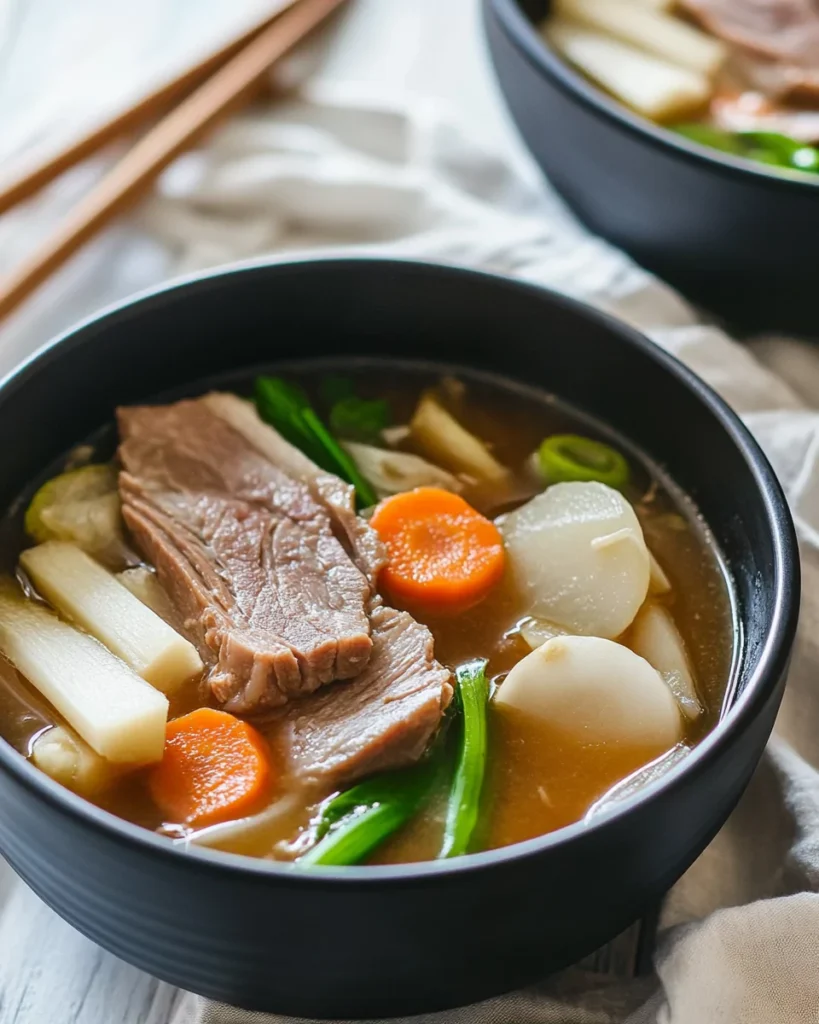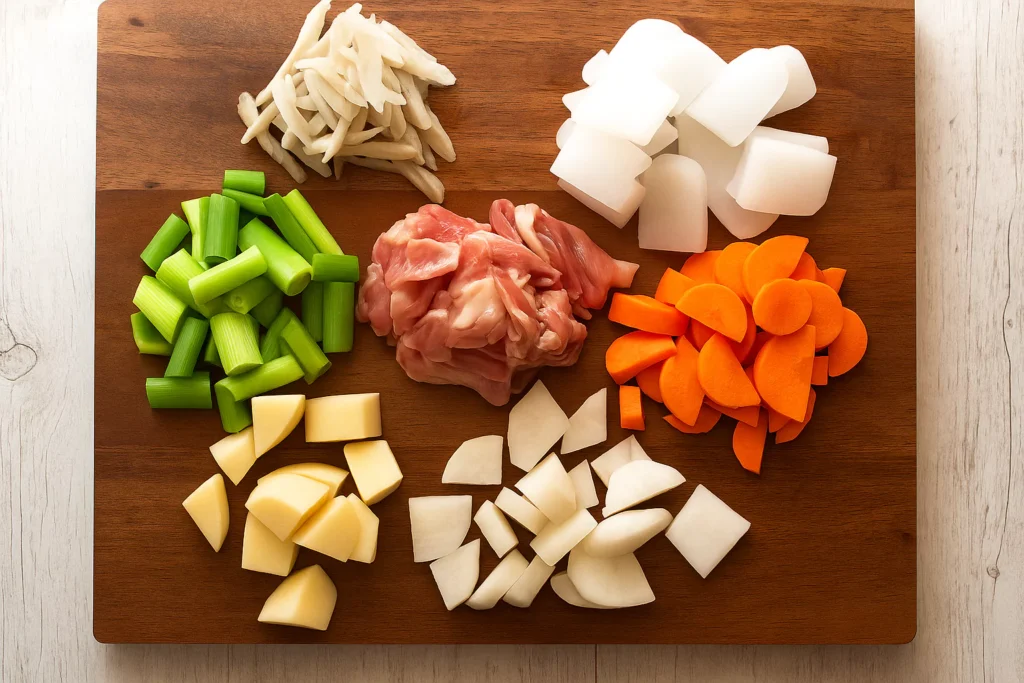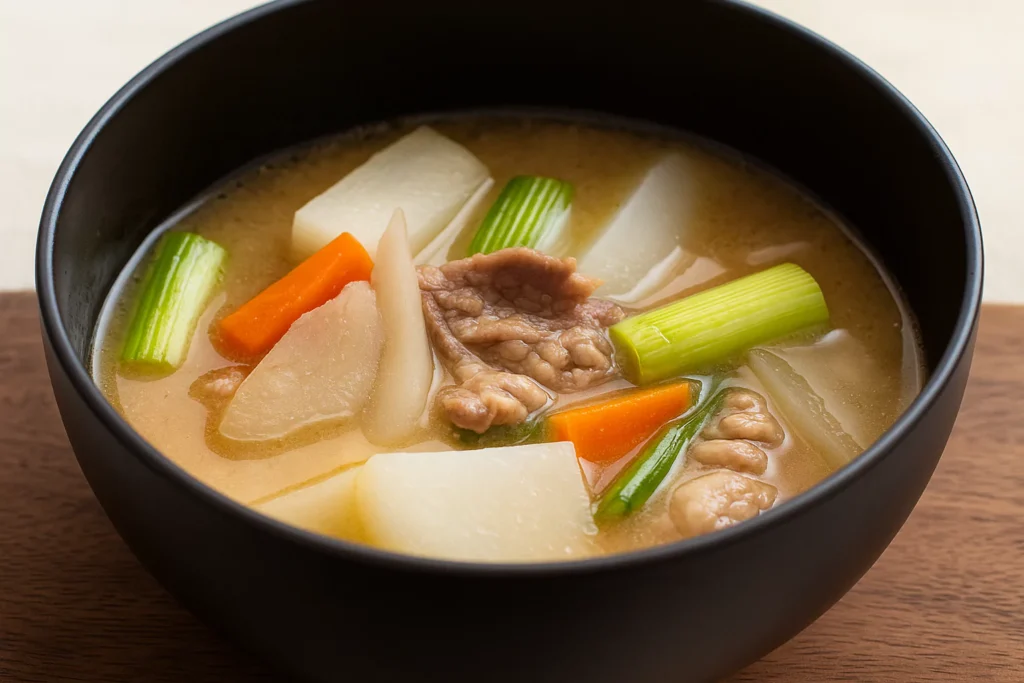Have you ever tasted a soup that warms your body and your heart? 💛 What if I told you there’s a Japanese comfort food that does just that—with juicy pork, fresh vegetables, and a deep umami flavor from miso? If you’re wondering what makes tonjiru so comforting and satisfying, you’re in the right place!
Whether it’s a chilly day or you’re simply craving a wholesome meal, tonjiru is the perfect answer. But here’s the best part—it’s quick, healthy, and super easy to make!
Table of Contents
🍜 What Is Tonjiru?
Tonjiru, also called butajiru (which means “pork soup” in Japanese), is a miso-based soup filled with thinly sliced pork belly and hearty vegetables. Unlike regular miso soup, this version is extra rich thanks to the pork and earthy ingredients like burdock root and daikon radish. 💪🌱
It’s a dish often served in Japanese homes and school lunches. The soup comes together in under 30 minutes, making it perfect for busy weeknights. 🕒✅
Difficulty: Easy
Prep Time: 10 mins
Cook Time: 20 mins
Servings: 4

🥕 What You’ll Need: Ingredients Breakdown
Here’s everything you need to make a soul-warming bowl of tonjiru. These ingredients come together like a warm hug from Japan! 🫶
🧾 Main Ingredients:
- 150g pork belly, thinly sliced – the star of the soup, adding flavor and richness
- 600ml dashi stock – a Japanese broth made from kombu and bonito flakes (or use instant dashi powder!)
- 2 tbsp miso paste – adds that famous umami flavor (white or red miso works)
🥦 Vegetables (feel free to swap based on what you have!)
- 100g daikon radish, peeled and sliced
- 100g carrots, cut into half-moons
- ½ block konnyaku (a jelly-like food made from yam), sliced
- 100g potatoes, cubed
- 40g burdock root (gobo), shredded or thinly sliced
- 2 scallions, cut into 1-inch pieces
✨ Garnish (optional but amazing)
- Thinly sliced white part of scallion (for a fancy touch)
- A pinch of shichimi togarashi (Japanese chili blend) for spice lovers 🌶️
🧾 Ingredient Notes:
You don’t need to stick strictly to pork belly for tonjiru, but whichever cut you use, make sure it’s thinly sliced. This helps it cook quickly and stay tender. Personally, I prefer pork belly because it adds extra depth and richness thanks to its natural fat. If you enjoy a meatier bite, slightly thicker slices also work well—just adjust the cooking time a bit. 🐖

As for the veggies, there’s plenty of flexibility! Traditional ingredients in tonjiru typically feature daikon, carrots, taro, burdock, konnyaku, and green onions. But feel free to get creative—onions, potatoes, tofu, mushrooms, string beans, or even aburaage (crispy fried tofu) make great additions. 🥕🍄
Let’s talk konnyaku for a second. It’s a firm, jelly-like food made from konnyaku potato flour. You’ll usually find it sold in blocks or shaped into little balls. n western Japan (Kansai), thinly sliced konnyaku is called ito konnyaku, while in eastern regions like Kanto, it’s referred to as shirataki.
Konnyaku is low in calories and packed with fiber. While it doesn’t carry much flavor on its own, it’s loved for its chewy texture and its ability to add volume and variety to dishes without making them heavy. 💡
👩🍳 How to Make Tonjiru – Step-by-Step
Follow these simple steps and enjoy the cozy aroma filling your kitchen. 😍
1. Sauté the Pork
Add a small amount of oil to a medium-sized pot and warm it over medium heat. Add the pork slices and cook over high heat until the meat turns white and slightly golden on the edges. This step builds flavor—don’t skip it!
2. Add the Veggies
Toss in all the vegetables except the scallions. Sauté the vegetables for a couple of minutes until they begin to soften. The potatoes will look a little see-through—perfect! 🥔✨
3. Pour in the Dashi
Add the dashi stock and bring everything to a boil. When the soup begins to boil, reduce the heat to a gentle simmer. Let it cook for about 10 minutes, or until the vegetables are nice and tender.
4. Stir in the Miso
Slowly mix the miso into the soup using a ladle or fine mesh strainer, making sure it fully blends without clumps. (Don’t just plop it in—it won’t mix well.) Once the miso is fully blended, toss in the scallion pieces. Let them simmer for 2-3 minutes.
5. Serve and Garnish
Ladle the soup into bowls, top with scallion slivers and a sprinkle of togarashi if you like it spicy. 🍜🔥

🥄 Time to Serve!
Serve tonjiru hot in medium bowls, either on its own or alongside a bowl of steamed rice. 🍚 It’s also amazing with onigiri (rice balls) or even some pickled vegetables on the side. Every bite is rich, flavorful, and deeply comforting.
🧊 How to Store Tonjiru (And Make Ahead!)
🥡 Leftovers?
Store any leftover tonjiru in a sealed container in the refrigerator, and enjoy it within 3 days. The flavors get even better overnight!
🔥 Reheating:
Just warm it gently on the stovetop or microwave. If it thickens too much, add a splash of water or dashi to loosen it up.
🌀 Fun Variations to Try!
Want to mix it up? Try these tasty twists:
- Swap pork belly for chicken thigh if you want a lighter version.
- Add tofu or shiitake mushrooms for a vegetarian-friendly soup (skip the pork and use kombu-only dashi).
- Try adding udon noodles to make it a full meal in a bowl! 🍜
🧠 Health Benefits of Tonjiru
You’ll be happy to know this soup isn’t just delicious—it’s good for you too! 💪
- Miso supports gut health with probiotics
- Dashi is light in calories yet rich in essential minerals.
- Root vegetables like daikon and burdock are great for digestion
- Pork belly offers protein and energy (moderation is key)
Tonjiru naturally contains no gluten and is completely dairy-free, requiring no special changes.
🥢 Love hearty Japanese comfort food? After enjoying tonjiru, you’ll definitely want to try Nikujaga (Japanese Meat and Potato Stew) a sweet and savory dish that’s just as satisfying and perfect for cozy nights!
🧺 FAQs About Tonjiru
❓ What does tonjiru taste like?
It has a bold, savory flavor with a hint of sweetness from the vegetables and a deep umami taste thanks to the miso and dashi broth.
❓ Can I use miso soup packets?
You can! Just make sure to reduce the amount of added miso so it’s not too salty.
❓ What’s a good miso substitute?
Soybean paste (doenjang) is close in flavor, but miso is best for authenticity.
❓ Is it okay to freeze tonjiru?
You can freeze it, but the potatoes and miso may change texture. For the best flavor, enjoy it right after cooking or within a couple of days from the refrigerator.
🎉 Final Thoughts: A Bowl Full of Comfort
If you’ve never tried tonjiru, now’s the time to bring this heartwarming Japanese classic into your kitchen. 🍲 It’s cozy, nourishing, and surprisingly easy to prepare. Whether you’re new to Japanese cooking or a seasoned pro, this soup is sure to win your heart (and stomach)!
Try it tonight, and don’t forget to share your cozy bowl with friends and family. ❤️🇯🇵
🌸 Curious about the culture behind Japanese comfort food? Discover how dishes like tonjiru connect to Japan’s rich heritage by exploring why Kyoto is the ultimate cultural destination. It’s the perfect place to experience traditional flavors, temples, and more! 🌿
